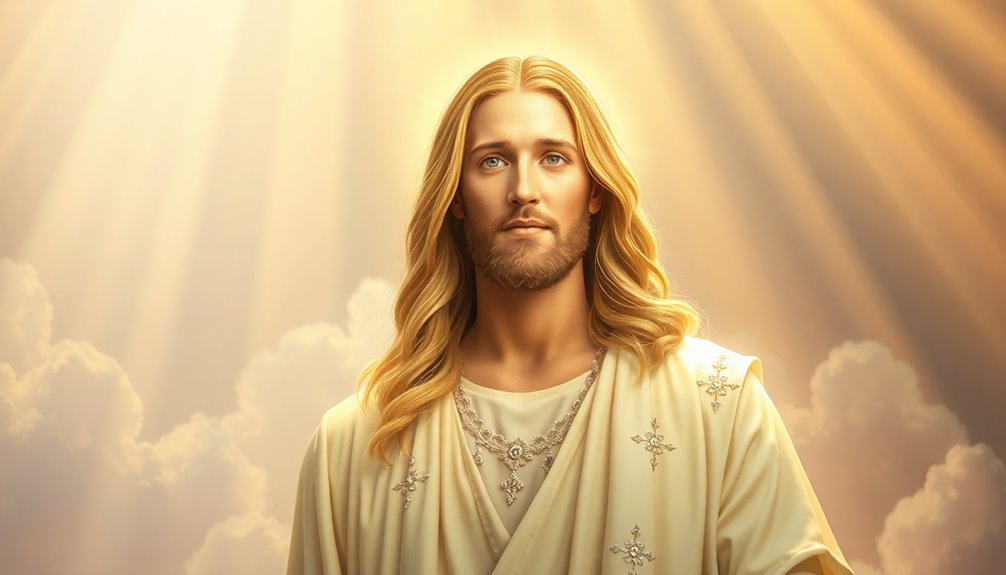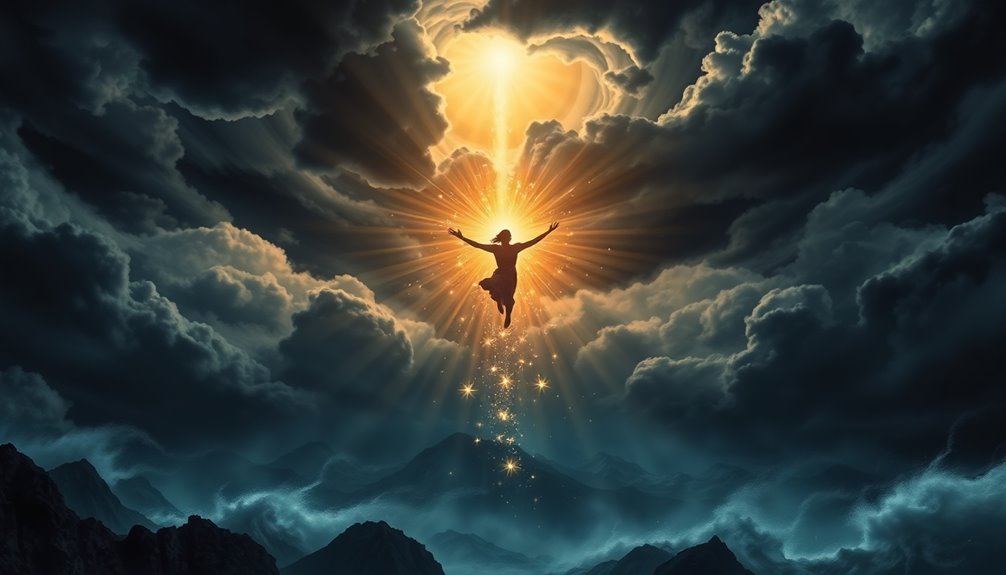In heaven, Jesus displays a radiant appearance that reflects His divine glory. You'd see Him with hair as white as wool and eyes blazing like fire. His face shines brilliantly, radiating holiness and power, reminiscent of the sun. Clothed in a brilliant robe, He embodies purity and majesty. This glorified form emphasizes the transformation from His earthly presence, maintaining essential features for recognition. The scars from His crucifixion remind you of His love and victory over sin. To explore more about the significance of His heavenly appearance, keep following along this fascinating journey.
Key Takeaways
- Jesus appears with hair white as snow and eyes like blazing fire, radiating holiness and power.
- His face shines like the sun, and His voice resonates like rushing waters, commanding reverence.
- His glorified body embodies divine glory, reflecting His majestic nature and authority.
- The Transfiguration reveals a glimpse of His heavenly appearance, emphasizing His divine essence.
- Recognized by His followers, Jesus' glorified body maintains essential features, allowing intimate communion with believers.
Introduction
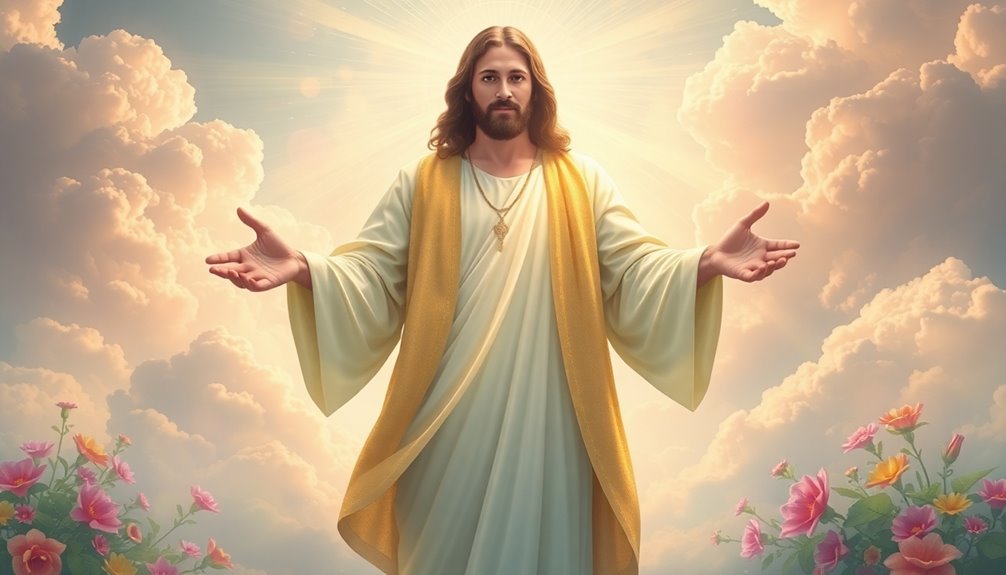
In the realm of faith and belief, many wonder what Jesus looks like in heaven. The descriptions found in the Bible provide a glimpse into His glorified body, which reflects both His divine nature and His earthly form. After His resurrection, Jesus retained the essence of His human appearance, allowing His disciples to recognize Him, yet He exhibited new, glorified properties that set Him apart.
The Transfiguration reveals His divine glory, showcasing His face shining like the sun and His clothes bright as light.
In heaven, Jesus is depicted as the slain Lamb, symbolizing His sacrificial death and resurrection. This imagery emphasizes the continuity of His human nature after His resurrection, underscoring the importance of His bodily form for intercession and communion with believers.
You might imagine that Jesus looks both familiar and awe-inspiring, a perfect blend of humanity and divinity. His fiery eyes and voice like rushing waters from Revelation paint a powerful picture of His glorified presence.
As you contemplate these descriptions, consider how they reflect the profound significance of Jesus' resurrected body in your relationship with Him in heaven.
Heavenly Appearance Descriptions

When you look at the primary Bible references, like Revelation and Matthew, you see vivid descriptions of Jesus' heavenly appearance that highlight His divine glory.
Secondary references, such as those in Daniel, add depth to your understanding of His transformed, yet recognizable, features.
Together, these scriptures paint a powerful picture of who Jesus is in Heaven.
Primary Bible References
The breathtaking depictions of Jesus' appearance in heaven convey His divine authority and glory, offering believers a glimpse into His majestic nature.
In Revelation 1:14-16, Jesus is described with hair white like wool and eyes like blazing fire, symbolizing His purity and power. His voice roars like rushing waters, emphasizing His commanding presence.
Revelation 19:13 portrays Him in a robe dipped in blood, marked as "King of Kings and Lord of Lords." This image highlights His victorious and sovereign status.
Daniel 10:5-6 adds to the vision of His glorified body, resembling precious beryl, and His face shining like lightning, radiating divine brilliance.
The Transfiguration in Matthew 17:2 reveals Jesus' face shining like the sun, with clothes that become white as light, underscoring His glorified state.
Additionally, Revelation 5:6 presents Jesus as a Lamb looking as though it had been slain, showcasing His sacrificial love and ongoing role as Redeemer.
Together, these verses illustrate the resurrected and glorified Jesus, reflecting His authority, beauty, and redemptive purpose in heaven.
Secondary Bible References
Many descriptions of Jesus' heavenly appearance in the Bible highlight His divine attributes and majesty. In Revelation 1:14-16, you see Jesus with hair white as snow and eyes like flames of fire, symbolizing His divine authority. This powerful image reflects His role as the exalted King.
Revelation 19:11-16 presents Him as a warrior on a white horse, emphasizing His victorious nature with a robe dipped in blood.
In Daniel 10:5-6, Jesus' physical body is described as looking like beryl, with a face like lightning and eyes like flaming torches, showcasing His radiant majesty.
During the Transfiguration in Matthew 17:2, His face shines like the sun, and His clothes become as white as light, revealing His divine nature to the apostles.
Finally, Revelation 5:6 portrays Jesus as a Lamb that looks as if it had been slain, reminding you of His sacrificial death and the glory of His resurrection.
These secondary references provide a vivid picture of how Jesus looks in heaven, emphasizing His unparalleled glory and the profound significance of His divine identity.
First-Century Jewish Customs
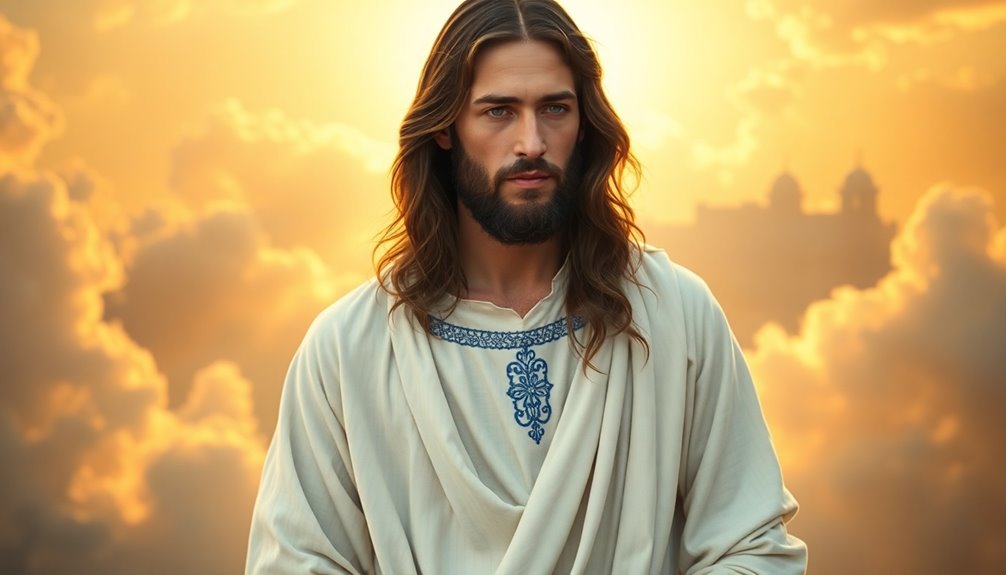
In first-century Jewish culture, community and family played crucial roles in daily life, with gatherings often revolving around shared meals and religious observances.
You'd find that ritual purity was vital, influencing how individuals prepared for communal gatherings and approached sacred spaces. Laws governed cleanliness, ensuring that everyone participated appropriately in worship.
Observing the Sabbath was a cornerstone of Jewish life. Each week, families paused from work to rest, reflect, and connect spiritually. This day of worship emphasized the importance of family time and fostered deep social bonds within the community.
Festivals like Passover, Yom Kippur, and Sukkot brought people together, commemorating significant historical events and agricultural cycles. These occasions were filled with joy, reflection, and a sense of unity, reinforcing cultural identity and shared beliefs.
You'd see that practices like circumcision, performed on the eighth day after birth, symbolized the covenant between God and Abraham, marking Jewish identity from infancy.
All these customs interwove daily life, shaping personal and communal experiences, and highlighting the significance of relationships in first-century Jewish society.
Heavenly Glory and Majesty
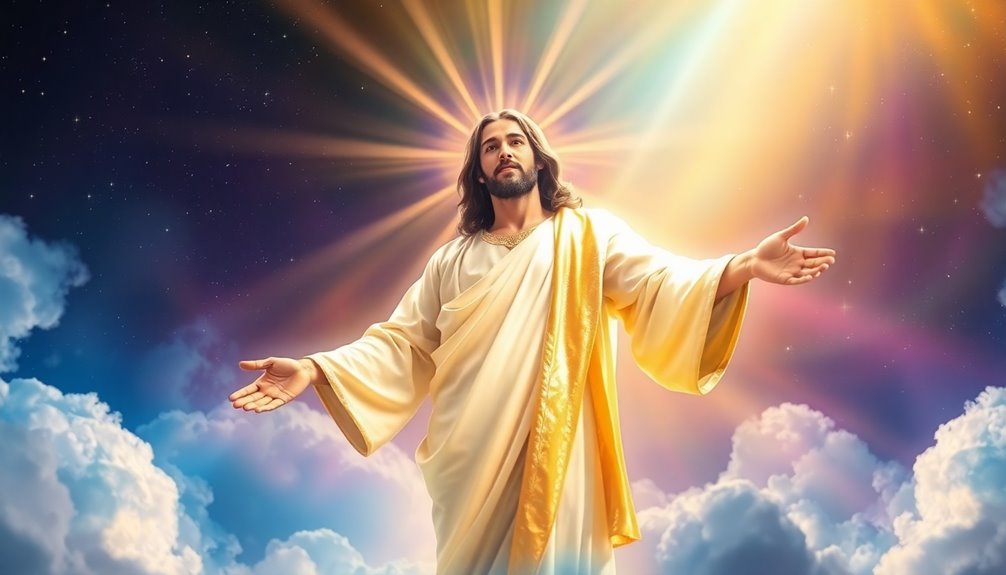
Amidst the splendor of heaven, Jesus reveals a glorified appearance that captivates all who behold Him. In this divine realm, His features shine with heavenly glory and majesty.
Picture His hair as white as snow, and His eyes like flames of fire, radiating holiness and power (Revelation 1:14-15). His face shines like the sun, reflecting the pure light of His essence, while His voice resonates like rushing waters, commanding attention and reverence (Revelation 1:15).
This glorious body reflects the culmination of His earthly sacrifice, symbolized in Revelation 5:6 as the slain Lamb. The Transfiguration event serves as a foreshadowing of this heavenly appearance, where His face shone brightly and His garments became white as light (Matthew 17:2).
In heaven, you're invited to witness the ultimate expression of Jesus' divine nature, transcending human understanding. The biblical imagery emphasizes His majesty, focusing on His essence rather than precise physical traits.
In heavenly places, you encounter not just a figure, but the embodiment of redemption and glory, forever changed by His love and sacrifice.
Debates on Jesus' Physicality

When you think about Jesus' physical form in heaven, misconceptions often arise regarding His appearance and the nature of His resurrection.
Many wonder how His glorified body retains its identity while also transcending earthly limitations.
Let's explore these debates to clarify what scripture and early teachings reveal about Jesus' physicality after His resurrection.
Address Misconceptions About Jesus' Form
Many people hold misconceptions about Jesus' physicality, often shaped by cultural and artistic interpretations rather than biblical truths.
It's essential to understand that Jesus retains a glorified physical form in heaven, distinct from His earthly appearance. The descriptions in Revelation and the Transfiguration indicate this transformation. While the Catechism asserts that His glorified body is indeed the same as the one that was crucified, it's now free from earthly limitations and imperfections (CCC 645).
After His resurrection, Jesus was initially unrecognizable to some disciples, suggesting that while He retains essential features, His appearance has undergone a significant transformation (Luke 24:16, John 20:14). This leads to misconceptions about what He truly looks like.
Theological perspectives emphasize that Jesus' appearance symbolizes perfect communion and divine glory, rather than specific physical traits (1 John 3:2).
Artistic representations often reflect historical biases, which can distort our understanding. Jesus likely had olive skin and dark hair typical of first-century Jews, contrasting sharply with many contemporary depictions.
Recognizing these truths helps clarify your understanding of Jesus' glorified form in heaven.
Doubts About Physical Resurrection
Doubts about Jesus' physical resurrection often stem from differing interpretations of scripture and the nature of His glorified body. Some question whether His resurrected form retains physicality or if it's merely spiritual.
However, historical creeds affirm that Jesus Christ maintains a glorified body that's both distinct from and continuous with His earthly form. In Acts 1:11, the accounts of His ascension support the belief that He'll return in the same manner, underscoring His physical resurrection.
The Catechism emphasizes that while His glorified body is free from earthly limitations, it remains recognizable as the crucified body. Early Church Fathers, including St. Thomas Aquinas, noted that Jesus' essential features are recognizable in His glorified state, reinforcing the continuity between His earthly and heavenly appearance.
Instances of recognition post-resurrection, such as in Luke 24:16 and John 20:14, suggest that understanding goes beyond mere physical identification. These encounters reflect the transformative nature of His resurrected body, which, while glorified, is still intimately connected to His human experience.
Ultimately, belief in Jesus' physical resurrection offers profound hope and assurance for our own future resurrected bodies.
Heavenly Worship Practices Today
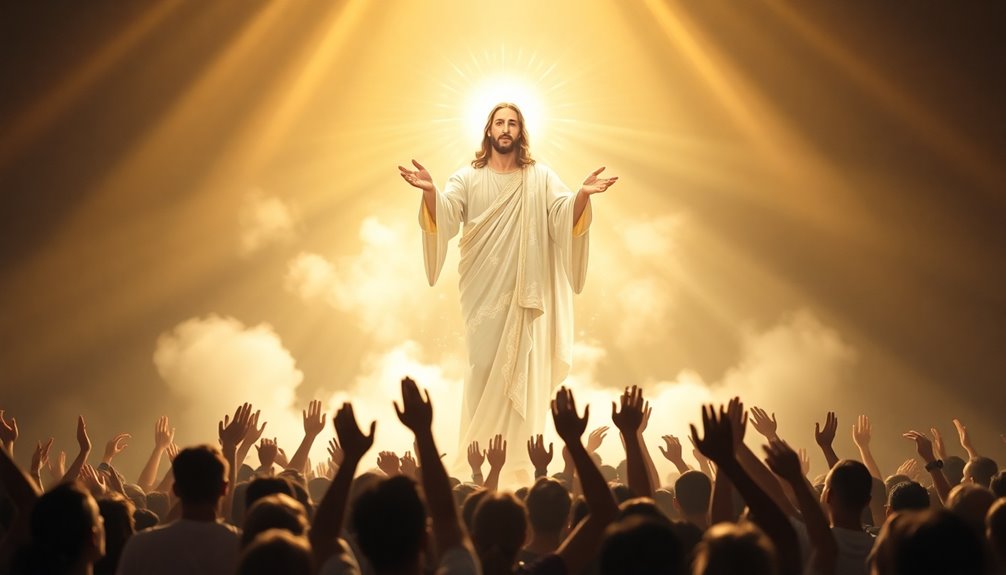
When you consider heavenly worship practices today, think about how they reflect a deep connection to divine beauty.
Your congregational experiences, whether through heartfelt singing or engaging prayer, can shape your understanding of God's presence.
As you participate in these practices, you might find yourself inspired to express your faith and appreciation in new and meaningful ways.
Personal Reflection on Divine Beauty
Embracing the beauty of Christ during worship can transform your experience, drawing you closer to His divine presence. When you reflect on the glorified Jesus, as described in Revelation, you can't help but feel a sense of awe and reverence. His radiant appearance and heavenly glory inspire you to envision His majesty and love, deepening your intimacy with God.
In contemporary worship settings, visual art, music, and symbolism—like light and vibrant colors—aim to capture this divine beauty. These elements create an atmosphere that invites you to engage with Jesus in a meaningful way. You might find that meditation on His attributes or participation in sacraments enhances your understanding of His transformative power.
As you focus on the glorified Christ, you're reminded of the promise of resurrection and the hope of seeing Him in His heavenly state. This personal reflection not only enriches your worship experience but also aligns your heart with the anticipation of His return.
Ultimately, your encounters with divine beauty during worship can lead to profound transformation, allowing you to experience the fullness of His presence each time you gather in His name.
Congregational Worship Experiences
Experiencing congregational worship today connects you with the heavenly practices depicted in Scripture, where angels and saints continually praise God. In these worship experiences, elements like singing, prayer, and Scripture reading reflect the reverence found in the heavenly throne room described in Isaiah 6 and Revelation 4.
Many churches adopt a liturgical structure that mirrors this order, emphasizing the profound presence of God during the service.
Communion plays a vital role in congregational worship, symbolizing your participation in the eternal banquet with Christ, as referenced in Matthew 26:29 and Revelation 19:9. This act not only connects you to the past but also to the future glory awaiting believers.
Contemporary worship styles enhance these experiences, utilizing multimedia and artistic expressions to create an immersive atmosphere that offers a glimpse of heaven's majesty.
Additionally, intercessory prayer within these gatherings highlights Jesus' ongoing mediatorial role in heaven, as noted in Hebrews 7:25. This practice reinforces the bond between your earthly worship and the divine realities of heavenly worship, making each congregational experience a profound encounter with God's presence and grace.
Heavenly Recognition of Jesus

Many people wonder how they'll recognize Jesus in heaven, given His glorified state. The good news is that His glorified body retains essential features that make Him recognizable. Biblical accounts indicate that those who encountered the resurrected Jesus, like Mary Magdalene and the disciples, recognized Him despite His transformed appearance (Luke 24:16, John 20:14). This suggests a continuity between His earthly and glorified forms.
The Catechism affirms that Jesus' glorified body is indeed the same as the crucified one but is free from earthly limitations (CCC 645). This continuity provides reassurance that you won't struggle to identify Him.
The early Church Fathers emphasized this aspect, suggesting that Jesus' physical characteristics would remain evident in His glorified state.
Moreover, the eternal presence of His crucifixion scars serves as a powerful symbol of victory over sin and death. These marks not only affirm His identity but also deepen the heavenly recognition of Jesus as the Savior.
Ultimately, you can find comfort in knowing that His recognizable features will invite you into intimate communion with Him for eternity.
Additional Resources

To further explore the nature of Jesus' appearance in heaven, a variety of resources can enhance your understanding. Randy Alcorn's book "Heaven" offers profound insights into the nature of glorified bodies. He emphasizes that these bodies will be recognizable and free from earthly imperfections, helping us grasp what this transformation might entail.
Logos Bible Software is another fantastic tool, providing in-depth resources for Bible study. It allows you to dive deeper into the biblical descriptions that outline how Jesus appears in His glorified state. Various articles also tackle questions surrounding His physical characteristics, discussing how recognition and transformation play significant roles post-resurrection.
Additionally, historical perspectives, including those from early Church Fathers, affirm that Jesus' glorified body reflects both His earthly appearance and divine attributes.
The Catechism of the Catholic Church further describes Jesus, stating that while His glorified body retains the essence of the crucified one, it possesses new properties that reveal His divine glory.
Exploring these resources can significantly enrich your understanding of Jesus' appearance in heaven and help us visualize the continuity between His earthly and glorified forms.
Frequently Asked Questions
What Does Jesus Look Like in Heaven Now?
When you consider what Jesus looks like now, envision a figure radiating divine glory. His hair's white like wool, eyes burning like flames, and feet gleam like polished bronze.
You might picture Him wearing a robe dipped in blood, symbolizing His sacrifice. His face shines brighter than the sun, reflecting His transformed, glorified body.
Though majestic, He retains a form that reminds you of His humanity, a victorious Lamb who overcame sin and death.
What Is the Description of Jesus in Heaven?
When you consider the description of Jesus in heaven, you think of His radiant appearance. His hair's white like wool, and His eyes burn like flames, conveying divine authority.
You visualize His voice, powerful like rushing waters, and His feet, glowing like polished brass.
You might recall the image of Him as the slain Lamb, embodying sacrifice and redemption.
This portrayal emphasizes His majesty and glory, evoking awe and reverence in your heart.
Can You See Jesus in Heaven?
You can see Jesus in heaven, but it's not just about physical sight.
When you arrive, your understanding of Him will transform, allowing you to recognize Him in ways beyond mere appearance. His glorified body will reflect His divine glory and humanity, including the scars that signify His sacrifice.
This encounter will be deeply spiritual, filled with love and recognition that transcends anything you've experienced on earth. You'll truly see Him as He is.
How Does the Bible Describe Jesus' Look?
The Bible describes Jesus in vivid, symbolic terms.
You'll find passages that mention His hair like wool, eyes like blazing fire, and feet like glowing bronze. His voice is powerful, akin to rushing waters.
These descriptions highlight His divine authority and glory, especially after His resurrection. Rather than detailing physical traits, the emphasis is on His nature and the significance of His identity, portraying Him as both a King and a sacrificial Lamb.

